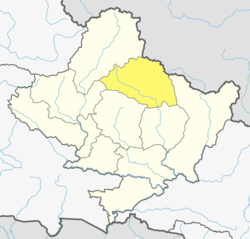Manang District, Nepal
District in Gandaki Pradesh, Nepal From Wikipedia, the free encyclopedia
District in Gandaki Pradesh, Nepal From Wikipedia, the free encyclopedia
Manang District (Nepali: मनाङ जिल्ला , in Gandaki Province, is one of the seventy-seven districts of Nepal. The district, with Chame as its district headquarters, covers an area of 2,246 km2 (867 sq mi) and in 2011 had a population of 6,538.[1]
Manang District
मनाङ | |
|---|---|
 Annapurna, Manang District | |
 Location of Manang (dark yellow) in Gandaki Province | |
| Country | |
| Province | Gandaki Province |
| Admin HQ. | Chame |
| Former HQ. | Thoche |
| Government | |
| • Type | Coordination committee |
| • Body | DCC, Manang |
| Area | |
| • Total | 2,246 km2 (867 sq mi) |
| Population (2011) | |
| • Total | 6,538 |
| • Density | 2.9/km2 (7.5/sq mi) |
| Time zone | UTC+05:45 (NPT) |
| Telephone Code | 066 |
| Website | ddcmanang |
The Thorung La pass, at 5,415 meters above sea level, connects the district with Mustang district by providing a route between the towns of Manang and Muktinath. Manang district gets the lowest amount of rainfall among the districts of Nepal as it lies to the north of the Himalayas, which block monsoon winds. The Manang Valley, which lies close to the Nepal-Tibet border, offers tremendous opportunities due to its rich natural flora and fauna. Three tracks start from here. The first, via Thorangla, Muktinath, and Mustang to Lhasa—a journey that takes four days; the second via Naur Khola and Naurgaon, which takes five days to Lhasa; and the third via Larkiya bazar, which is the one most commonly used by the people of Central Nepal.
Along with the Marwaris who have migrated from India to Nepal in large numbers, the Manangies are the best known traders of Nepal. They have received special dispensation from the King to trade in South East Asia, and travel abroad with precious stones and metals, musk, herbs and other items. They import ready-made garments, watches and electronic goods. Many of the Manangies spend as much as six months away from home, returning only during the summers. Many of them reside in Kathmandu, where their children study in English-medium schools. The parents' lack of proficiency in the English language is irrelevant as it in no way affects their trading skills.[citation needed]
Since the area was opened to outsiders in the late 1970s, many have switched from the traditional agriculture to hoteleering.
The trail from Manang to Muktinath has been used by the locals for hundreds of years to transport huge herds of sheep and yak in and out of Manang. It is an important route for the people of the region.
The northern parts of Manang Valley are dry, brown and desolate places, very different from the thick forests and brown green valleys of Sikkim and Eastern Nepal.


| Climate Zone[2] | Elevation Range | % of Area |
|---|---|---|
| Subtropical | 1,000 to 2,000 meters 3,300 to 6,600 ft. |
0.3% |
| Temperate | 2,000 to 3,000 meters 6,400 to 9,800 ft. |
3.7% |
| Subalpine | 3,000 to 4,000 meters 9,800 to 13,100 ft. |
14.6% |
| Alpine | 4,000 to 5,000 meters 13,100 to 16,400 ft. |
13.9% |
| Nival | above 5,000 meters | 25.4% |
| Trans-Himalayan[3] | 3,000 to 6,400 meters 9,800 to 21,000 ft. |
42.1% |
| Census year | Pop. | ±% p.a. | ||
|---|---|---|---|---|
| 1981 | 7,021 | — | ||
| 1991 | 5,363 | −2.66% | ||
| 2001 | 9,587 | +5.98% | ||
| 2011 | 6,538 | −3.76% | ||
| 2021 | 5,645 | −1.46% | ||
| ||||
| Source: Citypopulation[5] | ||||
At the time of the 2011 Nepal census, Manang District had a population of 6,538.
As their first language, 62.3% spoke Gurung, 16.2% Nepali, 8.1% Tamang, 7.4% Sherpa, 1.2% Magar, 0.9% Newari, 0.9% Thakali, 0.4% Kham, 0.3% Sign language, 0.2% Bhojpuri, 0.2% Bote, 0.2% Rai and 1.6% other languages.[6]
Ethnicity/caste: 57.1% were Gurung, 12.6% Tamang, 7.1% Ghale, 6.9% Bhote, 3.8% Kami, 2.5% Hill Brahmin, 2.3% Magar, 1.5% Chhetri, 1.5% Newar, 0.9% Damai/Dholi, 0.9% Thakali, 0.5% Rai, 0.3% Sherpa, 0.2% Bote, 0.2% Sarki and 1.6% others.[7]
Religion: 55.2% were Buddhist, 39.2% Hindu, 1.4% Christian, 0.5% Bon, 0.2% Prakriti, 0.1% Muslim and 3.4% others.[8]
Literacy: 72.0% could read and write, 0.7% could only read and 27.3% could neither read nor write.[9]
The district consists of four rural municipalities:[10]
Prior to the restructuring of the district, Manang District consisted of the following municipalities and village development committees:
Seamless Wikipedia browsing. On steroids.
Every time you click a link to Wikipedia, Wiktionary or Wikiquote in your browser's search results, it will show the modern Wikiwand interface.
Wikiwand extension is a five stars, simple, with minimum permission required to keep your browsing private, safe and transparent.